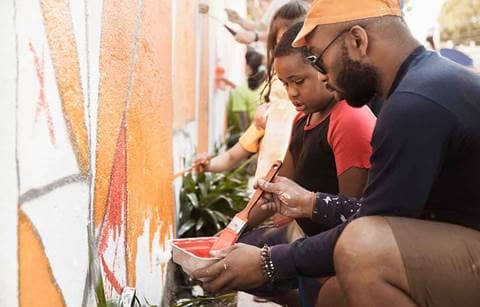The past two years have dealt business and government leaders challenges like no other. There’s no playbook for navigating a pandemic; still organizations have embraced change and innovated — despite or perhaps because of being faced with new challenges.
At Plante Moran’s recent Executive Forum “Learn From Leaders” panel, I was fortunate to moderate a discussion of these ideas with four other C-suite executives and leaders: Bruce Glazer, CFO of Kroenke Sports Entertainment; Jena Hausmann, CEO of Children’s Hospital Colorado; Derrill Rice, president and CEO of Plastic Components; and Councilwoman Priscilla Tyson of the city of Columbus.
In this article, they’ll share what the last year looked like for their organizations and industries as well as glimpses of where they want to go in the future. We’ll also get to know their organizations, the particular challenges they’ve faced, and how they embraced innovation and technology and try to look at remote work in new ways.
Bruce Glazer: Confronting uncertainty and helping the community
Uncertainty was the biggest challenge. While some businesses could operate, we had to shut down sports teams and large venues. It’s been a roller coaster ever since. Games were cancelled and then some continued in a bubble. We had no fans and then more fans. Then we had to consider how to handle COVID-19 precautions with crowds. Our arenas had to adapt to different protocols with each musical act that we hosted.
Our facilities became a resource. For so long, we were shut down and couldn’t put people to work. Thankfully, we have a great owner who didn’t have to furlough anyone and made the decision to pay people. We realized we could play a pivotal role in the community, so we hosted two of the largest testing and vaccination facilities in our area. I’m really proud of how we were able to provide assistance to the city and state. It was a good feeling that we could be an asset to help with public health and getting people back to work.
However, we’re also noticing the tension with those who want to work from home — and who can — versus those who must be on the floor. Moving an entire arena from an ice floor to a basketball court is a hands-on issue. Security is a hands-on issue. We’re one more organization that’s wrestling with that culturally and looking for solutions.
As a leader in unclear times, I’ve learned people need even more honesty. Even if the answer is, “We don’t know … yet,” it’s our duty to let our people know we’re already thinking about all of this. We’ve encouraged and enhanced our regular communications and our virtual connections. We’re working every day to ensure safety for our staff, to get operations up and running, to get people back to work. Communication and honesty with people are more important than ever.
Jena Hausman: Reimagining public health in times of crisis
Our core mission, which we’ve delivered on for more than a century, has been to provide care to those in need. Suddenly that meant more than it had previously. We had to think about public health in the context of our healthcare system, which had been tested like no other time in the last century. Becoming a lifeline for public health and personal safety regarding COVID-19 within our community was new for us — and innovation was critical.
We all know the best challenges come with disruption — and we were disrupted. Our lab became the most sophisticated microbiology lab in Colorado, quickly producing the first COVID-19 tests in the state. Our systems enabled us to rollout the vaccination process. It was an interesting reexamination of our mission as a healthcare system and the role we play in our community.
And, of course, technology was a big part of innovation. To give an example, pre-pandemic we conducted about 5,000 telehealth visits in a 12-month cycle. The governor then shut down elective healthcare in the state to preserve capacity for COVID-19 patients, and we had to determine how to convert to 5,000 telehealth visits a week. This was something I thought was a stretch in our five-year strategic plan, but we did it in 10 days. And we’re seeing the providers and patients still like this option. So, now that we’re fully open for in-office visits, we’re still holding at about 25% telehealth appointments.
But the dark side of technology for us is this remote work. The flexibility was helpful when we had to pivot quickly and preserve jobs, but in a hospital setting, two-thirds of workers need to show up in person to care for patients. We’ve now created this unhealthy part of our culture that pits those with the luxury of working from home against those who don’t have that option. It can be a strain on the culture. Everyone is seeing these new emerging cultural tensions, and that will be a critical decision point for leaders.
Derrill Rice: Testing manufacturers on every front
We were dealing with stressors everywhere. Fluctuation in demand made it difficult to plan and manage the business. We were considering our employees’ mental and physical health in new ways. People wanted confidence in job security — and they were struggling with childcare and virtual schooling. And our customers required new levels of responsiveness and reliability to remain financially stable.
Technology played a big role in our ability to persevere. It’s common now for those in manufacturing to invest in automation. This can be next-generation robots or a lights-out plant. We have one facility where the lights are out during the second and third shifts because everything is automated. Now we’re accelerating that technology across other operations. We’re seeing that more automated technology will allow us to operate with less dependency on labor resources.
People ask us if all jobs can be made remote, and that’s impossible. If you’re in finance or you’re a developer, maybe you can work at home, but many people are needed on the plant floor. It depends on the function of the job. We’ve found we need a balance between working at home and the cultural connectivity of shared spaces and impromptu conversations. So, each culture has to find its own solutions to these new dynamics.
The last 18–20 months have redefined what it means to lead during a time of crisis. It’s meant pivoting on every front, from technology and employee retention to safety in the workplace and reconsidering how we think about employee mental health. People are looking to our response. We saw that our workforce wanted to know there was a steady hand overseeing the organization. So, we stepped up our communications, embraced transparency, and leaned into flexibility across the organization.
Priscilla Tyson: Continuing to fulfill the mission of a local government despite pressure
We were a large urban center managing this public health crisis. Thankfully, we have a great public health department in Columbus, but suddenly they were inundated. Everyone was looking to their authority. They had to quickly coordinate with hospitals around the city’s response. They had to field calls from every business that wanted to understand how to make their decisions. And that wasn’t the only crisis. We were grappling with racial equity issues. We also saw more violence. COVID-19 exacerbated various existing problems.
Throughout this experience, we saw how innovation and technology were critical to us serving the public good. Early on, there was a 14-day period where we transitioned 2,000 employees to working from home. That involved providing staff laptops and portable equipment. So, what was good for our people was good for our community. Our situation is a little unique though. We’re not executives or business owners. We’re elected officials. So, we had to continue to think about how to move our city forward. We had to think about moving legislation onward and meeting with community members. We eventually hosted 50,000 online meetings to provide information to our residents on COVID-19 and also just to do the work of our cities.
As a reference point, we’re the 14th largest city in the country, serving 900,000 people and providing information to our residents. We wouldn’t have had success or moved through this portion of the pandemic without technology. It allowed us to meet the demands of our residents who wanted information. Thankfully, we invested in data management and integrity in 2019, which was crucial in helping with our city’s response.
As a leader, my focus was communication and keeping people healthy. Our residents and employees have health and wellness issues, especially mental health. We want people to be aware of services and to be able to receive services. As a local government, we know that businesses and public health and community all depend on people being at their best. Sometimes, we have to think outside of the box like when we teamed up with The Ohio State University alums to work with our people. There are so many resources, and a leader’s job is to make them accessible to people.
In conclusion
Even though these outstanding leaders are from different sectors, there are a variety of similarities in what they’ve gone through. They were all tasked with more responsibility and accountability than ever before, and yet they all saw opportunities to grow from those hard-earned lessons. I think, to me, that’s what resonated most — because when communities and business come together, everyone comes out stronger.





